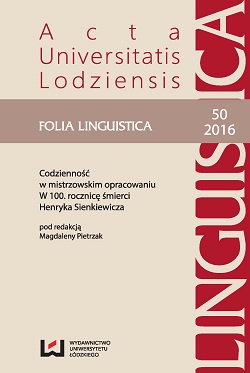Spory o dydaktyzm i sposoby jego wyrażania w polskich dziewiętnastowiecznych powieściach historycznych (zarys problematyki)
Disputes about didacticism and methods of its expressing
in the Polish nineteenth-century historical novels
Author(s): Iwona Żuraszek-RyśSubject(s): Polish Literature
Published by: Wydawnictwo Uniwersytetu Łódzkiego
Keywords: Polish historical novel; didacticism; archaisation;
Summary/Abstract: In this article one has analyzed the opinions on didacticism both of nineteenth-century authors and theorists as well as contemporary scholars writing about the nineteenth century. The quoted statements allow to draw a conclusion that both the nineteenth century theorists and practitioners were aware of the cognitive and didactic potential of historical novel. Attention was drawn to the opportunity to broaden cognitive horizons of the readers, providing them with specific knowledge about life, historical phenomena, shaping their views, ideological sentiments or patriotic attitudes. Therefore, historical novel played an important role in educating the public and shaping its national consciousness. In the case of this genre, didacticism manifests itself in several ways. One of them is a storyline based on historical events subordinated to a particular thesis. Writers taking historical subjects have therefore to face with the past, determine their attitude towards it. This obviously caused various discussions and polemics. The next plane on which didacticism manifests itself is the creation of literary characters. Entering characters into the novel was associated with giving them a distinctive positive or negative personal model. Another plane is language. Historical novel is a genre that is unlikely to do without archaic (although in Polish literature there are known examples of historical novels devoid of archaic words, for example Czerwone tarcze by Iwaszkiewicz). The writers seemed to realize, however, that the realistic representation of past epochs is not based on a comprehensive, total archaisation, but rather moderate, selective use of this type of styling. This attitude was dictated by, among others, attention to adapting the language to the reception possibilities of the readers.
Journal: Acta Universitatis Lodziensis. Folia Linguistica
- Issue Year: 2016
- Issue No: 50
- Page Range: 253-262
- Page Count: 10
- Language: Polish

